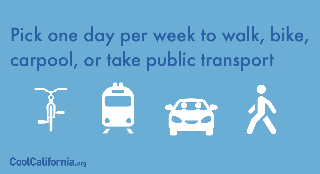Transportation related emissions make up 41% of our GHG footprint here in California. Your choices can make a huge impact as we transition to a more sustainable future. Transportation choices can help reduce greenhouse gas emissions.
Choose the Best Mode
- Walk or bike first.
- Ride transit.
- Carpool.
- Drive an electric vehicle.
1. Walk and Bike
Active transportation should be your first choice! Not only are walking, biking, scooting, and other human-powered transportation options the most sustainable modes - they're the best for YOU.
Walking and biking can not only make individuals healthier, they can make communities healthier and more sustainable by reducing air pollution from cars and traffic. Neighborhoods that are less dependent on motor vehicles, help make California’s streets safer for those who choose to bike or walk. Choosing to walk or bike not only improves your health, but the health of our communities!
Read about the health benefits of healthy activity here. Some highlights include:
- Children who bike to school are more fit and have a lower risk of being overweight.
- Adults living in highly walkable neighborhoods on average walk and bike more and have lower disease risk and improved heart health.
- Adults who commute by walking or biking lower their risk of suffering a stroke, heart attack, being diagnosed with diabetes, and overall mortality.
Choosing to walk or bike, even for only a few trips, can reduce the carbon footprint of an average household by up to 1,000 pounds (.5 tons) of CO2e annually. Use the Household Carbon Footprint Calculator to find out what other actions can save money and lower your carbon footprint.
2. Ride Transit
Riding public transportation is a great deal for your wallet (no more paying for parking!), carbon footprint, and your community. Public transportation produces lower emissions (per passenger mile) than private vehicles and continues to get cleaner under California's Innovative Clean Transit rule.
Riding transit also frees you from the stress of navigating and driving in traffic - providing valuable time to read, listen to podcasts, or join us on social media! (Twitter | Instagram | Facebook)
Choosing to take public transportation even for only a few trips, can reduce the carbon footprint of an average household by up to 6,000 pounds (3 tons) of CO2e annually. Use the Household Carbon Footprint Calculator to find out what other actions can save money and lower your carbon footprint.
3. Carpool and Link Trips
Carpooling: Carpooling to work is an easy way to significantly reduce the impact of your commute. Even driving with just one other person can reduce your annual GHG footprint by 2,000 pounds (1 ton) or more!
Bonus: You may get to drive in the HOV (High Occupancy Vehicle) or carpool lane on your way to and from work, saving time and money.
Combine Errands: Cold engine startups use twice as much fuel and pollute twice as much. That quick one-mile trip to the dry cleaners can pollute up to 70 percent as much as a ten-mile excursion with several stops. Combine short trips into one multipurpose trip with a warm engine and you will save on fuel and pollute less.
Trip linking is easy:
- Keep a running list of errands you need to do
- Try to match items on your list that are located near each other
- For example, if your child's school is located near your dry cleaner and post office, three trips could be linked together into one
- Give yourself enough time and plan ahead
- Think before you drive: "Do I really need to make this trip?" and "How can I combine this errand with another trip I'll be making this week?"
Carpooling can reduce the carbon footprint of an average household by up to 2,000 pounds (1 ton) of CO2e annually. Use the Household Carbon Footprint Calculator to find out what other actions can save money and lower your carbon footprint.
4. Electrify Your Transportation
Need a personal vehicle?
Visit the Car Shopper Resources at the California Clean Vehicle Rebate Project for an introduction and DriveClean.ca.gov to help you choose the right type of vehicle to meet your needs, and answer some common questions, such as:
- How far can I drive? (Farther than you think!)
- Will switching to an electric car save me money? (Spoiler: it might!)
- Are there any incentives for buying and electric car? (Yes!)
Additional helpful resources include MyGreenCar, which monitors your driving patterns and will identify the best vehicle for you, and UC Davis’ Electric Vehicle Explorer which maps out your daily commute and shows the cost for different cars.
Choosing a more efficient vehicle or a zero emission vehicle (ZEV) can reduce the carbon footprint of an average household by up to 16,200 pounds (8.1 tons) of CO2e annually. Use the Household Carbon Footprint Calculator to find out what other actions can save money and lower your carbon footprint.
| ☛Click to find funding and incentives!☚ | ☛Click for more on sustainable transportation!☚ |



